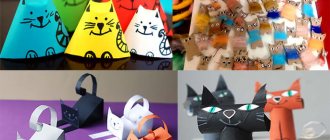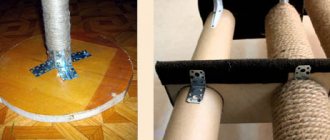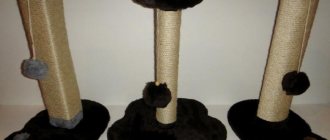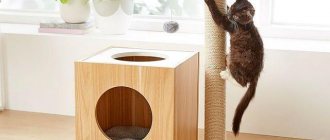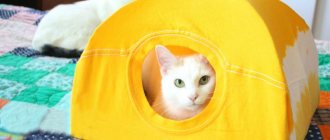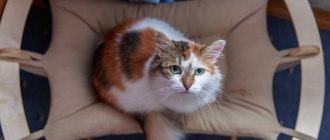Cats are probably the most popular pets in all countries. In Russia alone there are about 34 million of them in apartments. These affectionate purrs not only brighten up our loneliness, but also become true friends. And, of course, a caring owner always tries to provide them with favorable living conditions. One of the main vital needs of a cat is sharpening its claws. In this way they update their claws and put special marks. Sharpening claws is instinctive: even animals that lack them continue to try to do it anyway. Naturally, our furniture, carpets and even wallpaper suffer from them. To avoid this, be sure to get a scratching post and teach your cat to use it. The stores are full of both expensive and cheap options. And in this article we will tell you how to make a scratching post for cats with your own hands.
DIY scratching post for cats
Why do you need a scratching post?
In nature, claw marks of lions, tigers, and leopards are found on tree branches, high from the ground. Domestic cats have retained the habits of their wild relatives. She:
- necessary for cleaning claws from worn outer horny film;
- scratches will tell relatives: there is a representative of the species here;
- accompanies stretching;
- attracts attention.
Sharpening claws is a natural need for a cat
Not vitally important, like eating, sleeping or going to the litter box, but scratch marks will cause the animal to lose a significant amount of comfort. Owners have to regularly change chairs, upholstery on upholstered furniture, and throw out boxes. Purchasing a cat scratcher will help in part. How to choose her so that she will be successful with the beast?
- choose a covering: from corrugated cardboard to sisal, as long as the animal likes it;
- find a comfortable place - one where your pet likes to sharpen its claws, but don’t forget about yourself, everyone makes this choice together;
- think about the shape, color and fastening.
You may be able to find one that is approximately suitable at a pet store. But purchased products are disposable and will soon deteriorate with intensive use. It’s possible to make a repairable cat house with your own hands.
Shapes of scratches
How to design a cat scratcher? It depends on the size of the apartment, the cat’s manners and the imagination of the owners. Experts in cat psychology say: animals need to periodically remain alone where they can be found - at heights. Cat climbing frames are suitable for this:
- “cat trees” - branched structures with shelter,
- the cat house can be placed on the floor - with surfaces for “manicure” inside, on the roof or on the base of the structure;
- thin shelves mounted on the wall with covering in separate areas for claw points;
- flat or volumetric wall scratching post.
Choose a form factor based on the safety requirements of the animal and convenience for humans. Let's look at how to make a scratching post yourself from scrap materials. You have to make a set of elements and connect them in a certain sequence.
Required materials and tools
A cat's sense of smell is much more subtle and sensitive than a human's. Therefore, when making such an important and necessary attribute of a cat’s life as a scratching post, you need to use only natural materials that do not have a pronounced odor. Yes, this would be perfect:
- tree;
- jute, linen or sisal ropes;
- leg-split;
- sackcloth;
- hemp;
- pressed or corrugated cardboard;
- carpet
But artificial materials can cause allergies and cause serious harm to the cat’s health. For example, you should not make a scratching post from a plastic pipe - plastic has an unpleasant odor and is allergenic.
Another important advantage of products made from natural fibers is that they remove static electricity well.
The surface of the scratching post should be made rough and durable, but not too hard. The process of scratching should give the cat pleasure and relax it, and not bring unpleasant, and even more so, painful sensations to the animal, and cause broken claws.
The cat's claws should penetrate several millimeters deep into the fabric, tearing the fibers of which it is composed, but without clinging to them. From this point of view, the best solution is sisal rope.
- Try not to use nails and metal staples to connect the parts of the nail clipper, or fix them tightly and thoroughly so that your pet does not get hurt when cleaning its claws. It is advisable to place the fastening parts on the reverse side of the product.
- The material for the scratching post also depends on the size of the animal. If the cat is small, then it is better to give preference to models made of cardboard or corrugated cardboard - if the coating is too hard, the baby can damage its claws.
- However, large representatives of the cat family have stronger and harder claws, so it is worth making cloth for them from stronger and more durable materials. For a large cat, natural wood is suitable.
Only it is better to choose a tree that does not smell strongly and without knots, having first cleared it of bark.
And, of course, be guided by the tastes of your cat. Look at what your pet is sharpening its claws on now. Try to use the same or similar material when making homemade scratches. If he prefers doors, then a piece of wood will do.
If he “does a manicure” on rugs, then carpet will be the best choice; scratches the furniture upholstery - choose jute or sisal rope for covering (the latter is the most reliable and durable material, although the most expensive).
To create a scratching post you may need the following tools:
- threads;
- glue;
- scotch;
- compass;
- screws;
- stapler;
- stationery knife;
- drill;
- hammer and others.
Each model will have its own set of tools.
Top part
We have already stated that the pet chooses the upholstery. How to line a cat house or cover a surface for sharpening claws:
- carpet - cheap fabric for a scratching post, average maintenance, technically the most difficult to replace;
- jute rope - inexpensive, easy to replace, short-lived;
- sisal - the most durable, but also expensive;
- corrugated cardboard - cheap, but short-lived;
- with a wooden block - few people like it, but the labor costs when working with it are minimal.
Animals, of course, do not differentiate between sisal and jute (by the way, if you decide to try jute and like it, you can then replace the rope with sisal). Few people prefer unsanded wood, but sometimes it is the ideal scratching post for cats.
Frequent errors in manufacturing and assembly
- Often, when making a scratching post, some mistakes are made, the most basic of which are insufficient stability, incorrect materials, ill-conceived design.
- Any structure must be balanced and securely screwed. If it falls, the cat will get scared and stop using it.
- Purchasing the cheapest ready-made scratching posts. For their manufacture, the most fragile, low-quality materials are used, which, with frequent use, quickly become unusable. Such products can lead to injury to the cat, its paws, and claws.
- The owner thinks that the cat itself should understand the purpose of this new object. She needs to be taught, shown what the animal should do with her, and to interest the pet in every possible way.
- Wrong sizes. When developing drawings and diagrams, the owner does not take into account the size of his animal, its habits, habits, and character. The pet may simply not like such an item, and sometimes it does not correspond to its dimensions or weight.
A house for a Maine Coon should be larger than, for example, a house for a British or other breed.
The animal cannot use it comfortably. It is easier to train a small kitten than an adult who is used to sharpening her claws elsewhere. Such an animal must get used to new furniture gradually.
Base options
Item needed:
- strong enough to support the weight of the animal;
- lightweight so that bulky structures are not required for mounting to the wall;
- Receptive to glue well, good for processing with tools.
Cheapness is an important parameter, but not as much as for coating. The base is expected to last a long time. Is this always necessary? Assess the complexity and wear time of the craft. It may turn out that it is more rational to replace it completely than to remove the glue.
For the base take:
Note!
Kinusaiga technique for beginners: what is it, a description of creating paintings from threads
How to weave a figurine from rubber bands: how to learn to weave animals, toys and what you can make from rubber bands on a slingshot
- How to make flowers with your own hands from paper, fabric and scrap materials. We create bouquets of homemade artificial flowers
- plastic water and sewer pipes - they are easily sawed across and lengthwise, it is easy to make a frame of any shape from them with reliable fastenings from standard adapters;
- pieces of plywood of various thicknesses;
- sections of tree branches after sanitary pruning at the dacha (necessarily healthy fragments, so as not to bring pests into the house).
The branches can also be used for decoration: a cat lying on them, attached to the ceiling, will decorate any apartment.
Is it worth purchasing used items?
Some owners make just such a decision in the hope of saving money. But this is a fundamentally wrong approach, because objects may smell like other people’s animals, which will most likely only scare away yours. And no one can guarantee the health and hygiene of the previous user of the accessory, thereby you risk infecting your cat with unpleasant diseases.
For creative people, creating a scratching post for your pet will only be a joy. You can completely rely on your imagination and come up with its design yourself. A creative approach to work will help you create an interesting and original household item that will adequately and harmoniously decorate the interior of the room.
Horizontals
They are divided into shelves for walking, areas for resting or placing a “birdhouse” and hammocks.
The platforms can also serve as steps to make it easier for your pet to climb to the very top of the structure. They are made from plywood. Sheets Ш1 or Ш2 are suitable, any grade except IV (falling out knots and cracks will affect the strength), birch is better than pine needles (cats are sensitive to odors), moisture and fire resistance do not matter.
The recommended thickness is from 6 (if you have a not too large cat) to 10 mm. Covering them with a covering for the claw point is worth it if the structure will be on the floor. In other cases it is a matter of taste. The technology is the same as for vertical surfaces.
cat house
This is a shelter with a single entrance, located far from the routes of people, higher above the floor. Dimensional diagrams and drawings can be found at the end of the article. Cats love boxes. Your task is to create something similar, but one that fits into the interior.
If you plan to place the house on a cat tree, take care of its stability and balancing issues, but for this it is enough to have a building level and at least three support points for the plywood base.
Tips on how to make a cat house spend a lot of time on interior and exterior upholstery. An external one can be useful for a furry pet to sharpen its claws - but only if the shelter is not located at a height.
Otherwise, decorate it however you want. What will be useful inside is not upholstery, but a mattress that fits the internal size of the floor, possibly with sides. It can be taken out and washed. The animal doesn’t care, and it’s much easier to maintain hygiene.
Design of a sharpener for cats
Before starting work, you should familiarize yourself with important tips and recommendations:
- The height of the working column for sharpening claws should not be less than 100 mm;
- Beds and other accessories are located above the column;
- The diameter of the pillar is at least 100 mm;
- The house is installed on top of the entire structure;
- If there is more than one cat in the family, then the beds are installed on the same level;
- The base of the device must be strong, heavier than the weight of the pet, and its dimensions are quite large.
- If the object is created from a pipe, then its height should be twice the length of the cat.
- The cardboard sharpener is only suitable for kittens and small breeds.
- It is not necessary to hang toys on ropes in this structure.
In order for your pet to fall in love with this device, you need to follow some useful tips. You need to study the habits of your pet, and notice what he has chosen to realize his instinct.
For this reason, you can choose the type of structure and determine the location for it. The cat must be directed to the right place by taking its paws in your hands and running them along the rough surface of the sharpener. Pet the cat and treat her to something tasty.
Observing the movement of the animal to its favorite place, pick it up and take it to the scratching post. On furniture that is at risk from sharp claws, you can spray a few drops of citrus freshener. Cats do not like this scent, and it will repel the “attempt”. You need to be patient with getting your cat accustomed to the sharpener; this process is not quick.
The animal needs to be praised and treated, so the cat will quickly understand that sharpening its claws on a special device will only be praised.
How to make a cat house with a scratching post
How to make a house for a cat with a scratching post? A shelter located in a cat tree cannot function as a scratching post. Therefore it must be on the floor. The shape of the cat’s home in this case should be either cylindrical or with a gable roof.
In the first case, a PVC sewer pipe is suitable. They come in diameters of 300, 400 and 500 mm. They cover the outside of the tube in the same way as vertical scratching posts. The second one will require plywood. Make the roof higher and longer.
What models are there?
It would seem that there is nothing complicated about it: bring a log or board from the street, put it against the wall - and you don’t have to worry about the safety of the furniture and wallpaper. In reality, everything is more complicated. Each cat has its own character and habits. Therefore, you need to select a scratching post individually, after first observing your pet.
There are several varieties suitable for Maine Coons:
- Scratching post-bed.
- Column.
- Vertical scratching post mounted on the wall.
- Playhouse.
Crafts made from corrugated cardboard
The simplest scratching post for cats is made from corrugated cardboard. To do this, unfold an ordinary box and cut it into strips 8-12 cm wide. Then they are either glued together in layers or rolled into a “snail”. It is often recommended to fasten the layers together with PVA glue, but pets lick and chew such products, so make a starch paste at home.
Device
Cat on a bed
To tear through the cat’s claws, at worst, a simple post or board will suffice, pos. 1 in Fig. However, it is better to complement it with a bed, pos. 2. Firstly, in nature, cat markers are not equivalent. One of them, with an elevated bench for relaxation and an observation deck above it, is the main one, the capital, so to speak. It is not necessarily in the center, it can be on the periphery. The cat's territory in the home is limited. You can do without boundary (contour) markers, but the main one will give the cat dignity, which, in turn, can well decorate the interior, see fig. on right.
Scratching posts for cats with a bed
But to combine a scratching post with a house, and even installed below, as in pos. 3, should not. In natural conditions, the cat's den is never combined with the main marker, for safety reasons. Some exceptions are cats of Asian origin: Siamese, Bengal, Abyssinian, etc., the territory of whose ancestors in the jungle is limited to an area of just one tree. But then the house must be elevated and equipped with 2 exits: a spare one perpendicular to the main one and opens onto an additional platform, pos. 4.
It is best if the scratching post with a bed and viewing platform is not a straight column, but a branched one, somewhat reminiscent of a tree, pos. 5. This can be built from cardboard pipes, see below. And on to the next. rice. – drawings of scratching posts with a climbing frame and platforms: on the left for energetic and jumping cats, and on the right for phlegmatic and sedate cats.
Drawings of scratching posts with beds and climbing frames
About the sites
Houses, toys, climbing frames and beds for cats are actually a different topic. In relation to scratching posts with platforms, it would be appropriate to say that the bed and the “observatory” do not need to be covered: cats have soft fur of their own. If you want to visually ennoble the product, then you don’t need to fasten the fabric like furniture, with nails or staples: metal can tear off a claw if it gets caught, and it conducts electricity too well for cats.
Cat areas are lined with PVA glue: when dried, it is odorless and is harmless and indifferent to cats. Step-by-step instructions for covering a cat bed with fabric are as follows:
- We cut with an allowance for the edge thickness plus 25-30 mm;
- We cut out the base (plywood or board 16 mm thick) with rounded corners so that the folds on them are small or can be completely dispersed;
- Apply glue to the upper part in rays and along the contour, see fig. on right. It is better to do this with a brush to immediately disperse the glue in a thin layer;
- Immediately, before the glue begins to set, we apply the fabric;
- We coat the edge with glue and, together with it, under the platform along the contour by 35-40 mm;
- We fold the fabric over the edge and tuck it under;
- From the bottom we pull the tight-fitting thread with a needle, zigzag along and across;
- Straighten the folds at the corners;
- We dry it for a day, there is no need to apply pressure;
- We cut off the excess fabric at the bottom along with the threads;
- Instead of overcasting, we impregnate the fold of the fabric on the underside with the same PVA, diluted by half with water.
Fastening
What fasteners are made of depends on the shape of the product. If you choose plywood, make sure to provide space for tight hinges and place them on glue before you begin to attach the outer covering.
If the base is voluminous, then a plastic clamp or metal tape will do. Please note that the craft will have to be periodically removed from the wall, so a detachable mount is preferable.
Shelves with scratchers for cats are attached like any other shelves; they can be additionally secured with triangles made of plywood.
A DIY scratching post is the best method to get what you and your cats need. If you're not sure which design will work, start with corrugated cardboard. This is short-lived, but it will allow you to decide on your pet’s tastes before making a more complex stationary structure.
Carpet scratch board
You can quickly and easily make your own carpet scratching post. To do this you will need:
- Wooden board or piece of chipboard.
- A piece of carpet or old carpet.
- Nails.
- Hammer.
The size of the wooden canvas is selected based on the size of the cat, because the structure made can be used as a bed and as a claw sharpener.
How to make a nail clipper:
- Place the rug with the wrong side up.
- Stepping back from the edge of the carpet, place the board.
- Wrap part of the carpet over the board and secure with nails along the entire edge.
- Carry out the same actions with the second part of the carpet. If the two layers overlap, they can be cut off with a knife or left as this will create an extra springy feel for the cat.
For the cat to start using the scratching post, just turn it over to the other side. If a fairly heavy tree is chosen for the scratcher, then it may not be secured, and the cat will still not turn it over.
DIY scratching post: photo examples of beautiful options
Please repost
0
